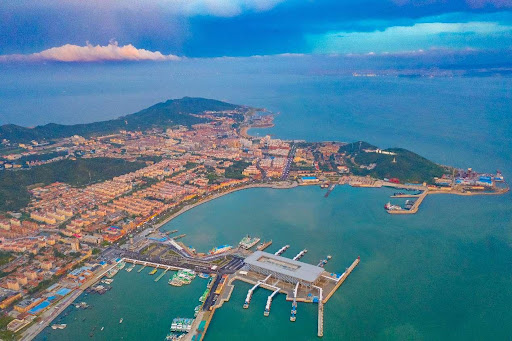By Dai Linfeng, People’s Daily
For most diners, seafood is simply a delicacy. But on Changdao Island in east China’s Shandong province, it represents something more: a climate asset.
For instance, for local fisherman Wang Delian, the briny bounty of the sea comes with a new calculation: carbon offsets.”Each square ofsilky kelp fixesaround 0.2 kilograms of carbon annually,” he explained. “One mu of plump oysters – about 667 square meters – absorbs around 1.4 tons of carbon dioxideeach year. And a single ton of scallops? That’s worth 0.25 tons of carbon dioxide, or the equivalent of planting 16 trees.”
Not long ago, Wang’scompany earned him a one-million-yuan ($136,544) blue ocean loan – not backed by property or equipment, but bythe 20,900 tons of carbon dioxide his oyster farm has absorbed. Here, fresh air has become collateral, and the ocean – a ledger of ecological credit.
Wang is just one of many riding this blue-green wave. Daqianshan Island, under Changdao’s jurisdiction, has taken the concept of sustainability a step further, becoming China’sfirst island to record over 2,000 tons of negative carbon emissions – meaning the island now captures more carbon than it emits.
A decade ago, such achievements were unimaginable. In winter, the island’s500 coal-fired boilers consumed over 50,000 tons of coal annually to heat aquaculture ponds. Poorly managed nearshore fish farming worsened water quality, leading to severe algal blooms and ecological stress.
In recent years, Changdao Island has reclaimed 18,000 mu of nearshore aquaculture zones and dismantled 860,000 square meters of shoreline hatcheries. As a result, greenhouse gas emissions plummeted nearly 50 percentbetween 2016 and 2023. As carbon-intensive practices receded, ecosystems began to recover. The skies brightened, the waters cleared, and the air grew cleaner.
This campaign to “retreat aquaculture and restore the sea” has replaced the short-term focus on harvest yields with a longer-term vision – one that values carbon sinks. It marks a fundamental recalibration of the region’s development model, where ecological restoration and economic planning now move in tandem.
However, scaling back traditional aquaculture raised hard questions about livelihoods. Yet for those like Wang, it also created new opportunities. Today, Wangoversees 150,000 oyster cages, more than triple his 2023 count, as the industry shifts toward deep-sea ranching – a more sustainable, carbon-absorbing alternative.
As fishery resources are reimagined as carbon sink assets, Changdao’sfishermen – once guardians of ecology – are becoming primary beneficiaries of sustainable development. By aligning emission reductions with economic growth, the island is not only preserving its beautiful shores, but also unlocking powerful momentum for ocean-driven prosperity.
That transition is being powered, in part, by green innovation. Take the artificial reefsdotting Changdao’s seabed for example: built from durable basalt, these reefs are equipped with underwater cameras and wireless sensorsto track ocean currents and marine life in real time. More than 1.3 million cubic meters of these reefs have been deployed, spurring nutrient upwelling and creating fertile habitat for carbon-sequestering shellfish and algae. So far, these “underwater carbon vaults” have offset over 100,000 tons of carbon dioxide equivalents – each seaweed strand and oyster shell playing its part in a vast, living carbon factory.
Changdao’sstory is no longer unique.Across China’s vast maritime territory, island communities are embracing a similar blueprint: reviving ecosystems, enhancing coastal living environments,leveraging unique marine resources, and integrating cultural tourism into the fabric of local economies.
With a focus on greener islands, cleaner beaches, clearer waters, and more vibrant biodiversity, many regions in China are exploring new ways to understand, manage, and benefit from the ocean. By cherishing its blue skies and seas as it would cherish life itself, the country is steering its marine economy toward higher quality and greater efficiency- ensuring that the ocean remains a source of sustainable well-being for generations to come.
